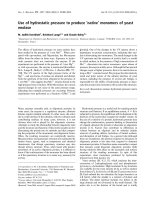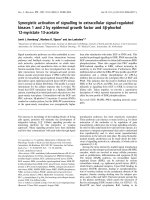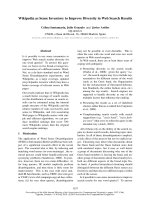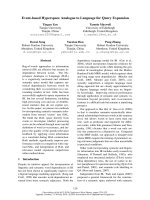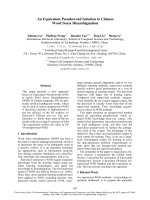Báo cáo khoa học: "Withdrawing may be preferable to withholding" ppsx
Bạn đang xem bản rút gọn của tài liệu. Xem và tải ngay bản đầy đủ của tài liệu tại đây (51.13 KB, 4 trang )
226
DNE = do not escalate; DNR = do not resuscitate; ICU = intensive care unit.
Critical Care June 2005 Vol 9 No 3 Vincent
Abstract
The majority of deaths on the intensive care unit now occur
following a decision to limit life-sustaining therapy, and end-of-life
decision making is an accepted and important part of modern
intensive care medical practice. Such decisions can essentially
take one of two forms: withdrawing – the removal of a therapy that
has been started in an attempt to sustain life but is not, or is no
longer, effective – and withholding – the decision not to make
further therapeutic interventions. Despite wide agreement by
Western ethicists that there is no ethical difference between these
two approaches, these issues continue to generate considerable
debate. In this article, I will provide arguments why, although the
two actions are indeed ethically equivalent, withdrawing life-
sustaining therapy may in fact be preferable to withholding.
Introduction
End-of-life decision making for the intensive care unit (ICU)
patient has been a hot topic in recent years, with the
acknowledgement that such practice is common worldwide
[1] and with a new openness among doctors and laypersons
regarding the once rather taboo subject of death. Indeed,
because the majority of ICU deaths now occur following a
decision to limit life-sustaining therapy [2–6], it is important
that these often difficult ethical areas be discussed openly.
Essentially, a decision to limit life-sustaining therapy can take
one of two forms: withholding or withdrawing. Withdrawal of
therapy is relatively easily defined as the removal of a therapy
that was started in an attempt to sustain life but has become
futile and is just prolonging the dying process. Withdrawal
usually concerns therapies such as mechanical ventilation
and administration of vasoactive agents. Withholding therapy,
on the other hand, concerns the concept of no therapeutic
escalation. Perhaps the most frequent example of this is the
do not resuscitate (DNR) order (or DNAR – do not attempt to
resuscitate). Withholding resuscitation efforts will almost
inevitably result in death from a cardiac arrest should one
occur. It is important to make this decision in advance
because once the cardiac arrest occurs there is no time to
think – each second counts. In many advanced cases the
DNR order is not sufficient (e.g. the patient with terminal
cancer or just very advanced age), and hence do not escalate
(DNE) orders (e.g. no mechanical ventilation in respiratory
failure or no extracorporeal support in terminal renal failure)
may be used. However, it is important to define clearly what is
included in a DNE order because less aggressive
interventions such as antibiotic use or nasogastric tube
feeding may not be seen as significant escalation and could
still be given.
The vast majority of doctors accept the principal and
application of withholding; indeed, if life-sustaining therapies
were not withheld from some patients, ICUs would be full of
terminally ill patients with no hope of recovery. The only real
objectors to the withholding of therapy are a few individuals
with very strongly held religious beliefs who maintain that life
must be sustained at all costs. Indeed, modern medical
progress increasingly allows us to define the exact moment of
death, and patients can certainly be kept ‘alive’ almost
indefinitely with the aid of mechanical ventilators, artificial
feeds and organ support strategies, among other measures.
However, what quality of life do such people have, if they are
permanently unconscious and totally reliant on medical
expertise for even the most rudimentary of bodily functions.
Medical progress in supportive therapies that enable organ
functions to be maintained while a patient recovers from a
serious illness is indeed remarkable, and should be used for
those in whom it is appropriate, but it should not be abused
to maintain ‘life’ that is without quality or meaning indefinitely.
Indeed, this goes against all four of the basic ethical laws
(see below).
Withdrawal of therapy is often seen as less acceptable [7].
Although it is clearly more difficult to discontinue than not to
start, I shall argue that withdrawal should be permitted, that it
Commentary
Withdrawing may be preferable to withholding
Jean-Louis Vincent
Head, Department of Intensive Care, Erasme Hospital, Free University of Brussels, Belgium
Corresponding author: Jean-Louis Vincent,
Published online: 4 March 2005 Critical Care 2005, 9:226-229 (DOI 10.1186/cc3486)
This article is online at />© 2005 BioMed Central Ltd
See related commentary by Levin and Sprung, page 230 [ />227
Available online />is ethically equivalent to withholding, and that it may even be
preferable to withholding in some cases.
Withdrawal should be permitted
There are two reasons why withdrawal of therapy should be
allowed. First, if withdrawal of therapy were not permitted,
then ICUs would be full of hopelessly ill patients receiving
(often expensive) therapies that no longer benefit them. This
process would be against the four ethical principles.
1. Autonomy – who wishes to remain supported ‘artificially’ if
the situation is hopeless? This is the reason why so many
individuals now wish to make advance directives; they are
afraid of becoming a ‘vegetable’ and being a burden to
their relatives and loved ones.
2. Beneficence – what is the benefit to the patient of
continuing a therapy that carries no advantage?
3. Nonmaleficence – even with optimal analgo-sedation,
continuing ineffective therapies can cause distress and
discomfort (e.g. suctioning, etc.).
4. Distributive justice – by continuing ineffective therapy, an
ICU bed may be blocked and not available for another
patient who may benefit from ICU care. In addition, the
costs of the futile care could be better employed
elsewhere.
The second reason why withdrawal of therapy should be
allowed is that if withdrawal of therapy is not permitted then
this may introduce a degree of hesitation into our actions
when time is of the essence. For example, in a patient with
acute respiratory failure, we may hesitate before intubating
the trachea to institute mechanical ventilation because we are
unsure of the history of that patient and want to be certain we
do not start a therapy that will turn out to be futile but cannot
later be withdrawn. However, in the patient who will benefit
from the therapy, reflection – even for a few seconds – may
make all the difference to their chances of survival. If we know
that we can withdraw a therapy at a later date, then each
patient will receive timely emergency care.
Withdrawal is ethically equivalent to
withholding at the end of life
Much has been written about the ethical distinction, or lack
thereof, between withdrawing and withholding therapy at the
end of life. Withdrawing has been seen as an ‘action’ rather
than the passive ‘omission’ of withholding [8], but is doing
something ethically any worse, or better, than not doing it if
the end result is the same. For example, in the patient who is
unable to breathe spontaneously, the active decision to stop
mechanical ventilation will have the same immediate
consequences as the ‘passive’ decision not to start
mechanical ventilation in the first place – the patient will not
be ventilated (Fig. 1). In each case, whether withholding or
withdrawing, we decide which treatment is to be applied in
the immediate future, and the immediate result will be the
same regardless of the situation prior to the decision.
Western ethicists have largely defended this view of
equivalence [5,9–12], and various groups have published
guidelines supporting this standpoint. For example, the
Belgian Society of Intensive Care Medicine [13] states clearly
that there is no ethical or moral difference between
withholding and withdrawing life-sustaining therapy, and the
British Medical Association’s guidelines [14] state that,
‘Although emotionally it may be easier to withhold treatment
than to withdraw that which has been started, there are no
legal, or necessary morally relevant, differences between the
two actions’.
Withdrawal may be better than withholding
Allowing withdrawal of therapy gives the patient every chance
of benefiting from that therapy. For example, consider a frail,
elderly, atherosclerotic patient who now develops a lung
infection. It is probably the end of their life (‘pneumonia is the
old man’s friend’), but the prognosis is not absolutely sure.
Should we admit the patient to the ICU for a trial of
mechanical ventilation while we wait for the antibiotics to
clear the infection, or should we leave them on the floor with
a probably fatal outcome. Without accurate objective
measures of prognosis, physicians are often called upon to
make a clinical judgement about the likely outcome in
individual patients; such judgements are not always accurate
[15], and if the decision is made to withhold therapy then no
allowance is made for the possibility that the prognostic
conclusion may be wrong. By allowing a so-called ‘ICU test’,
in which the patient is admitted to the ICU for a trial, they are
at least given a chance; if there is some improvement after
2–3 days then fine, but if there is no such improvement then
treatment will be withdrawn. Importantly, if this approach is
followed, then the patient and certainly the relatives must be
Figure 1
Similarities between withholding and withdrawing mechanical
ventilation at the end of life. Each mechanical breath is represented by
a vertical line. Whether the patient is already receiving mechanical
ventilation or not, the decision relates to whether to apply it from now
(interrupted vertical lines), and the consequences of that decision will
be the same.
WITHHOLDING
WITHDRAWING
TIME
228
Critical Care June 2005 Vol 9 No 3 Vincent
aware that this is just a ‘test’, that the chances of survival are
slim, and that therapy will be withdrawn if it is not seen to be
effective. Failure to communicate adequately in this situation
could create false hopes and expectations, but withholding
therapy from such a patient does not allow them even that
small glimmer of hope.
In our own experience in Brussels we frequently give patients
the benefit of the doubt and offer them an ICU or therapeutic
trial [16], and hence withdrawal of therapy is more common
than withholding. Of 109 deaths over a 3-month period, 50
were preceded by a decision to forgo life support: 46 by a
withdrawal decision and just four by a withhold decision.
Importantly, members of the ICU staff, both doctors and
nurses, were globally satisfied with the decisions made.
Higher rates of withdrawal than of withholding have been
reported in other studies. In a French study [17] 69% of end-
of-life decisions were to withdraw and 31% were to withhold,
and in the USA Prendergast and Luce [18] reported that
78% of end-of-life decisions were to withdraw and 12% were
to withhold.
Essentials when withdrawing therapy: good
communication and explicit decisions
End-of-life decisions should be made in advance whenever
possible. These are difficult issues, and it is often easier to
postpone them, to put them off for tomorrow. Some doctors
prefer not to think about the future, particularly if it is one that
may not be classically termed a medical ‘success’; however,
death should not be seen as a failure, but rather as a natural
and necessary process. How often do we hear ‘if she
deteriorates, let me know’, or ‘we’ll talk about it if his organ
function deteriorates, but at the moment he’s stable’?
However, what happens when the deterioration occurs
suddenly in the middle of the night or when the doctor is
unavailable? All likely eventualities must be discussed and
planned for before they arise. This is particularly true for
decisions to withhold therapy because there is often less time
when the acute situation requiring therapy to be withheld or
started arises. Preparing for the worst outcome in advance
gives everyone time to reflect, to say what they feel and to be
involved in the decision. It is also important that end-of-life
decisions no longer be made by the ‘paternalistic’ physician
alone, but rather that they be ‘shared’ decisions [19]. These
decisions should be made by consensus, after open
discussion involving nurses and other allied health care
personnel (e.g. the physiotherapist who has appreciated the
patient’s urge to fight the disease process) involved with the
patient and their care, and of course the patient, if possible,
and the relatives. However, such decisions should not be left
to the relatives alone because this is too great a burden for
them, and ultimately it is the physician who is responsible for
administering or discontinuing any treatment. Any such
discussions and decisions should be documented clearly in
the patient notes; in our institution we use ‘green sheets’
(easily identified in the often thick patient charts), which are
clearly identifiable for all members of staff to consult
whenever the need arises.
Conclusion
End-of-life decision making is an important and widely
accepted part of modern intensive care medical practice [1].
Much time and discussion has been given to the differences
between withdrawing and withholding therapy but, as I
outline above, these are ethically and morally identical
concepts; withdrawal of therapy should be permitted and
may even be preferable to withholding therapy. In all cases
the patient should be at the centre of our preoccupations. If
our treatment does not benefit the patient (futile therapy) then
we are duty bound to stop it without undue delay. Continuing
mechanical ventilation or extracorporeal renal support in a
patient who has no real chances of recovering a meaningful
life is of no use and should be stopped, exactly as it should
not be started if there is no chance that it will benefit the
patient.
Death in the ICU can risk becoming a technological,
impersonal event. We as doctors are privileged to be able to
assist our patients in their final journey through the dying
process. As such, we have a duty to ensure that our patients
die with dignity. Although we may stop active treatment, we
must never stop patient care; withdrawal of therapy does not
mean withdrawal of care.
Withdrawing and withholding life-sustaining
therapies are not the same: response to
commentary by Levin and Sprung
In their article, Levin and Sprung [20] stress that withholding
and withdrawing are different. Of course the acts of
withholding and withdrawing are not the same in practical
terms, but I would still argue that, ethically, there is no
difference; the end result is the same. I agree that, as shown
in numerous questionnaires and surveys, withdrawal is often
felt to be more difficult than withholding [7,8,21,22], but this
does not contradict my belief that the two are ethically
identical. The fact that one may be more difficult to put into
practice than the other does not make a difference to the end
result.
Some patients with withholding orders may indeed leave the
hospital alive; however, there is ‘withholding’ and
‘withholding’, in the sense that deciding to withhold life
support in the event of a cardiac arrest is quite different from
the decision to withhold it in the presence of a cardiac arrest.
In the former situation, the patient may very well leave the
hospital alive, like many other patients with DNR orders. In the
latter situation death is by far the most likely possibility, as
when active life support is withdrawn.
Withdrawing life-sustaining therapy is thus equivalent to
withholding it and, as elaborated in my original commentary
above, may even be preferable. I believe that we must have
229
the conscience – I would even say the courage – to stop a
treatment that no longer makes sense, that can provide no
further benefit to the patient (principle of beneficience), that
may cause discomfort or even pain (maleficience), and that
prolongs the use of limited resources (distributive justice).
Regarding the decision making process itself, of course a
patient who is competent should make the decision to
withdraw or withhold therapy, but this is an uncommon
situation in the ICU. When patients are incapable of making
an informed decision themselves, relatives must be told of
and involved in the discussions, but they should not be the
ones to decide. Like many others, I believe that asking
relatives to make such end-of-life decisions is unacceptable;
it is unfair to place such a heavy burden on their shoulders at
an already difficult time (especially when they do not have the
required medical knowledge and expertise) and, in addition,
their decision process may be altered by emotive personal
reactions (in one direction or the other) and possibly even by
personal interest. These final decisions must rest firmly with
the physician in charge, in consultation with members of the
medical team.
Competing interests
The author(s) declare that they have no competing interests.
References
1. Veatch RM: Limiting life support: a world-wide consensus?
Crit Care Med 2004, 32:597-598.
2. Prendergast TJ, Claessens MT, Luce JM: A national survey of
end-of-life care for critically ill patients. Am J Respir Crit Care
Med 1998, 158:1163-1167.
3. Eidelman LA, Jakobson DJ, Pizov R, Geber D, Leibovitz L, Sprung
CL: Foregoing life-sustaining treatment in an Israeli ICU.
Intensive Care Med 1998, 24:162-166.
4. Holzapfel L, Demingeon G, Piralla B, Biot L, Nallet B: A four-step
protocol for limitation of treatment in terminal care. An obser-
vational study in 475 intensive care unit patients. Intensive
Care Med 2002, 28:1309-1315.
5. Winter B, Cohen S: ABC of intensive care. Withdrawal of treat-
ment. BMJ 1999, 319:306-308.
6. Buckley TA, Joynt GM, Tan PY, Cheng CA, Yap FH: Limitation of
life support: frequency and practice in a Hong Kong intensive
care unit. Crit Care Med 2004, 32:415-420.
7. Vincent JL: Forgoing life support in Western European inten-
sive care units: The results of an ethical questionnaire. Crit
Care Med 1999, 27:1626-1633.
8. Melltorp G, Nilstun T: The difference between withholding and
withdrawing life-sustaining treatment. Intensive Care Med
1997, 23:1264-1267.
9. Meisel A: Legal myths about terminating life support. Arch
Intern Med 1991, 151:1497-1502.
10. Anonymous: Withholding and withdrawing life-sustaining
therapy. This Official Statement of the American Thoracic
Society was adopted by the ATS Board of Directors, March
1991. Am Rev Respir Dis 1991, 144:726-731.
11. Fairman RP: Withdrawing life-sustaining treatment: lessons
from Nancy Cruzan. Arch Intern Med 1992, 152:25-27.
12. Luttrell S: Withdrawing or withholding life prolonging treat-
ment. BMJ 1999, 318:1709-1710.
13. Ferdinande P, Berre J, Colardyn P, Damas P, de Marre F,
Devlieger H, Groenen M, Grosjean P, Installe E, Lamy M, et al.:
End of life in intensive care [in French]. Réanimation 2001,
10:340-341.
14. British Medical Association: Withholding and Withdrawing Life-
prolonging Medical Treatment: Guidance for Decision-making.
London: BMJ Books; 2001.
15. Gusmao VF, Polito LF, Melot C, Vincent JL: Can the experienced
ICU physician predict ICU length of stay and outcome better
than less experienced colleagues? Intensive Care Med 2004,
30:655-659.
16. Gajewska K, Schroeder M, de Marre F, Vincent JL: Analysis of
terminal events in 109 successive deaths in a Belgian inten-
sive care unit. Intensive Care Med 2004, 30:1224-1227.
17. Ferrand E, Robert R, Ingrand P, Lemaire F: Withholding and
withdrawal of life support in intensive-care units in France: a
prospective survey. French LATAREA Group. Lancet 2001,
357:9-14.
18. Prendergast TJ, Luce JM: Increasing incidence of withholding
and withdrawal of life support from the critically ill. Am J
Respir Crit Care Med 1997, 155:15-20.
19. Carlet J, Thijs LG, Antonelli M, Cassell J, Cox P, Hill N, Hinds C,
Pimentel JM, Reinhart K, Thompson BT: Challenges in end-of-
life care in the ICU. Statement of the 5th International Con-
sensus Conference in Critical Care: Brussels, Belgium, April
2003. Intensive Care Med 2004, 30:770-784.
20. Levin PD, Sprung CL: Withdrawing and withholding life sus-
taining therapies are not the same. Crit Care 2005, 9:230-232.
21. Solomon MZ, O’Donnell L, Jennings B, Guilfoy V, Wolf SM, Nolan
K, Jackson R, Koch-Weser D, Donnelley S: Decisions near the
end of life: professional views on life-sustaining treatments.
Am J Public Health 1993, 83:14-23.
22. Giannini A, Pessina A, Tacchi EM: End-of-life decisions in inten-
sive care units: attitudes of physicians in an Italian urban
setting. Intensive Care Med 2003, 29:1902-1910.
Available online />

